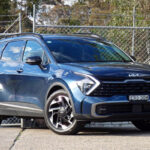 Despite the fact that it already sells the cleanest range of cars on the Australian market, the Australian BMW importer is not letting up. It comes as no surprise that the German marque that’s well know for providing machines for keen drivers hasn’t let performance slip, in fact it labels its clean, green machines as the iPerformance range.
Despite the fact that it already sells the cleanest range of cars on the Australian market, the Australian BMW importer is not letting up. It comes as no surprise that the German marque that’s well know for providing machines for keen drivers hasn’t let performance slip, in fact it labels its clean, green machines as the iPerformance range.
Latest to join the BMW range is the 3 Series 330e petrol-electric hybrid. It joins the BMW X5 xDrive 40e we reviewed last month. These are the two biggest selling model series in the BMW range so the German giant is in there boots and all.
The 330e has a realistic range of 28 to 32 kilometres on electric power alone. BMW points out that statistically the average commute by Australians living in metro areas is 15.6 km to it’s possible to go all week without using petrol. If you can charge at work and home you can live a fair way out to town.
BMW 330e can be charged from a standard electric powerpoint in about 3.5 hours, from a dedicated BMW BMW iWallbox in 2.25 hours, or at public charging stations. There are currently (excuse the pun) 262 public charging stations Australian wide, 256 of them provide free electricity. The Wallbox is priced at $1750 plus installation costs.
An electric motor is fitted between the 2.0-litre four-cylinder petrol engine and the eight-speed conventional automatic. Maximum combined power is 185 kW, with top torque of 420 Nm. Thus the 330e has the same peak power as a pure petrol BMW 330i; but the big torque inherent in electric motors means the 330e has 70 Nm more grunt than the 330i.
The 330e is heavier than the 330i but still manages to jump from zero to 100 km/h in 6.1 seconds. That tag of iPerformance certainly applies…
However, the 330e has 100 litres less boot space than the 330i, the missing room due to the bulky battery pack under the rear floor. Luggage space can be increased by folding down the 40/20/60 rear seat backrests.
Visually, the BMW 330e looks almost the same as any other 3 Series. Giveaways are a charging socket panel located in the left front guard and “eDrive” badges on the tailgate, engine cover and doorsill strips.
Naturally, the readouts on the dashboard are different as the 330e provides information on driving and the different choices of driving modes. The latter allows pure electric, petrol only, or combinations of the two.
On the road we found the BMW 330e hybrid smooth, quite and comfortable. Most of the drive route set out by the company for the media launch was on suburban roads close to Melbourne, with a very short freeway section. There was no chance to test handling, that will come later when we test the car in our home area.
At speeds up to 30 km/h the 330e makes a discreet sound when operating on electric power only to alert pedestrians who don’t look before crossing the road.
Cleverly, the hybrid’s suspension settings lean slightly more in the comfort direction when compared with the BMW 330i petrol. Thus reflecting the fact that hybrid drivers are keener on economy rather than blasting around bends. Not that the hybrid’s going to disappoint –
it has a front to rear balance of 48 / 52 to the dynamics are still impressive.
BMW Australia is to be commended on its positive action in introducing hybrid and pure electric vehicles to Australia.
Australian governments continue to refuse to give incentives to people who want to buy electric or hybrid cars. At the latest round of talks between all involved parties incentives were requested by the car industry representatives. Yet again none were given. When are our governments going to wake up to themselves?













